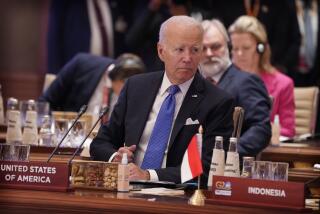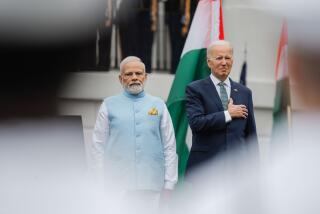INTERNATIONAL BUSINESS: SPOTLIGHT ON INDIA : Primed for Power : Huge Potential Lies in India--but U.S. Firms Wary
- Share via
Every developing nation has its tests of corporate machismo. In India, executives trade horror stories about electrical power outages.
“I was talking to a contractor not so long ago and his record last year was 13 power cuts in one day,” said Julian Archer, managing director of Birla Parsons, a Delhi-based joint venture of Parsons Corp., a giant Pasadena-based engineering and construction firm.
For Archer, those anecdotes add up to one of the world’s most promising energy markets, one that Parsons can hardly afford to ignore. India, which is chronically 8% short of its basic power needs, estimates it will need to triple its present capacity in the next 15 years to meet the future demands of the world’s sixth-largest economy.
While China and Southeast Asia have captured the lion’s share of attention from the business community in recent years, India--which abandoned socialist economic policies for the free market in 1991--has moved sharply higher on the overseas priority list for U.S. energy companies, cereal makers, auto manufacturers and others. They are eyeing a potential market of 900 million people emerging from decades of economic isolation.
The ruling Congress Party’s 1991 move to slash tariffs, privatize state-owned businesses and ease restrictions on foreign investment has paid off with a 5% growth rate and created a burgeoning market for cellular phones, foreign cars, satellite television and luxury condominiums.
In November alone, the Indian government approved 153 foreign projects totaling $5.1 billion, more than in any previous entire year.
But Archer and other U.S. executives are plotting their moves into India very cautiously, having watched several high-profile U.S. ventures run afoul of anti-foreign sentiments expressed by Hindu nationalists and other opposition politicians.
Critics of India’s market reforms argue that the government is putting the needs of foreign companies ahead of its people, many of whom still live in extreme poverty in shantytowns lacking electricity, clean water and indoor plumbing.
A violent confrontation with local villagers and environmentalists persuaded DuPont Corp. to move a proposed $190-million nylon plant from the southern state of Goa to the more receptive Tamil Nadu. A Kentucky Fried Chicken outlet was shut down by the Delhi state government last November after two flies were allegedly found on the premises. The closure was vacated by the Delhi High Court and the eatery is now doing a roaring business.
The most prominent foreign fiasco was Enron Corp.’s proposed $2.8-billion power project, which was scrapped in August when the Maharashtra state government objected to the terms of the contract. After months of talks, the Indian state’s leaders finally gave the go-ahead last week to a new contract which provides them with much cheaper power and better terms. Enron executives hope to have the project back on track within 90 days.
The apparent resolution of the Enron controversy--along with the compromises reached in the DuPont and KFC ventures--demonstrate that India’s system is workable, if not perfect, its leaders say.
“This will encourage the foreign investors to view India in the right sense,” said Y.P Srivastava, spokesman for the Federation of Indian Chambers of Commerce and Industry.
*
For the Indian government, the Enron case was a painful introduction to the volatile mixture of market economics with partisan politics. During a recent visit to Los Angeles, Shyamala Balasubramanian Cowsik, the deputy chief of mission at the Indian Embassy in Washington, asked for patience from U.S. investors, given her government’s relative inexperience with capitalism.
“It’s like trying to learn a violin solo in public,” she said.
Enron also taught U.S. businesses about survival tactics for the Indian marketplace, including the need to cultivate contacts on all sides of the political fence, the importance of a well-placed local partner and the value of working closely with the local communities.
“Indians in general are somewhat suspicious and guarded, based on their history of colonialism,” explained Tej Mariyappa, a management consultant with Santa Monica-based Ulysses International. “That suspicion still runs deep in both the private and public sector.”
For some, the negative impact of the Enron case on India’s image was exaggerated.
“Most foreign investors understood at a very early stage that Enron was purely a political game,” said David Kadarauch, head of research at Jardine Fleming India Ltd.
But the political game promises to heat up again soon, given the hotly contested general election scheduled for April. Foreigners seem certain to become the target of campaign rhetoric as opposition politicians fall back on their customary nationalistic sentiments to build support.
Yet business leaders are hopeful that India’s economic liberalization will continue no matter what the election’s outcome. In a meeting last year in London, Lal Krishna Advani, the president of the Hindu nationalist Bharatiya Janata Party, said, “If we do not get foreign investment, India is sunk as a country.”
“I think Enron and a lot of other posturing going on currently is election gambit and rhetoric,” said Shiv Grewal, an India specialist at the Los Angeles law firm of Graham & James. “After [the election], you’re going to see that disappear. Even the right-wing [Bharatiya Janata Party] is really a party of the traders.”
Such obstacles may have deterred some U.S investors, but interest remains keen. The economic reforms have been a big boost to U.S.-India trade, which has grown by 46% since 1991.
Michigan-based CMS Energy Corp. has made India its top priority in Asia. Chief Executive William McCormick hopes at least one of his company’s major projects--a $250-million hydroelectric plant in Andhra Pradesh and a $300-million facility in the state of Tamil Nadu--will get final approval in the next few months. The U.S. energy company also is bidding on several other projects in India.
And global auto makers are rushing into India, where the market is dominated by obsolete European designs. Ford Motor Co. plans to invest $600 million to $800 million in a joint venture which will produce the latest versions of the European Fiesta and Escort.
One of India’s biggest success stories is its software and computer industries, which have benefited from a large pool of skilled managers and technical personnel and a low-cost work force, many of whom speak English.
India’s answer to California’s Silicon Valley is the Bangalore region, where real estate prices have exploded with the influx of foreign companies. Other urban areas are experiencing similar price escalation. Bombay now ranks among the world’s most expensive cities in which to live.
Bobbi Sahni, whose Anaheim-based firm, Star Investments, markets Indian real estate in this country, said this property boom has now attracted the attention of overseas Indians who had previously concentrated their investments in U.S. apartment buildings and small hotels.
“Earlier, they [overseas Indians] wanted to come out of India and invest in California,” the Indian expatriate said. “Now, they’re going home.”
*
Still, the problems are daunting. In addition to energy shortages, the decades of relative economic isolation have left India with a crumbling infrastructure of roads, airports and telecommunications facilities. Corruption is endemic and a maze of government regulations keeps projects from moving ahead quickly, in spite of promises to streamline the approval process for foreign investors.
“If we do not have proper power and roads and legislation [for] land acquisition, how can you expect the foreign companies to invest in India?” asked Rahul Bajaj, the chairman of Bajaj Auto Ltd., a leading Indian vehicle manufacturer.
India’s investment figures reflect both the potential and the frustrating reality for foreigners: While a record $4.3 billion in foreign projects got the green light in 1994, only $950 million was actually spent.
In recent months, India has received some high-profile warnings to move more quickly or lose out to China and the developing economies of Southeast Asia, which are competing for the same investment dollars.
At a meeting earlier this month in New Delhi, Lee Kuan Yew, former prime minister of Singapore, told his audience that India’s lingering fears of economic colonialism are “outmoded” and irrelevant.
“Politics of self-reliance are no longer relevant in an interdependent world with fast-changing technology,” he said.
S. Gopal of The Times’ New Delhi Bureau contributed to this report.
(BEGIN TEXT OF INFOBOX / INFOGRAPHIC)
Awakening Giant
Since India loosened its restrictive trade policies in 1991, foreign investment has increased sharply. But the bureaucratic obstacles and delays faced by foreign firms are reflected in the fact that only about a third of the dollar investments approved by the Indian government have actually been spent. Foreign investment in India since 1991, in billions:
1995
Investments approved: $5.1
Actual investments: $1.7
* Investments tallied through October 1995.
U.S. exports to India changed dramatically after India revised its trade policies in 1991, accelerating a shift from a rural to industrial economy. Exports in 1991 and ‘93:
1991
Fertilizers: 57.2%
Aircraft equipment & parts: 15.1%
Measuring instruments: 14.1%
Other: 13.6%
1993
Aircraft equipment & parts: 54.5%
Fertilizers: 13.3%
Engines, motors & non-electric parts: 13.0%
Other: 19.2%
Sources: Indian Embassy; U.S. Commerce Department, International Trade Administration; Reserve Bank of India. Researched by JENNIFER OLDHAM / Los Angeles Times
More to Read
Inside the business of entertainment
The Wide Shot brings you news, analysis and insights on everything from streaming wars to production — and what it all means for the future.
You may occasionally receive promotional content from the Los Angeles Times.










